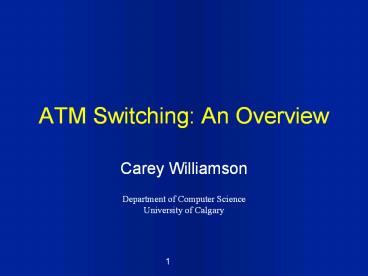ATM%20Switching:%20An%20Overview - PowerPoint PPT Presentation
Title:
ATM%20Switching:%20An%20Overview
Description:
ATM switches are central to the operation of ATM networks ... e.g., leaky bucket, dual leaky bucket. can provide 'traffic shaping' ... – PowerPoint PPT presentation
Number of Views:76
Avg rating:3.0/5.0
Title: ATM%20Switching:%20An%20Overview
1
ATM Switching An Overview
- Carey Williamson
Department of Computer Science University of
Calgary
2
Introduction
- ATM switches are central to the operation of ATM
networks - Lots of research on ATM switch design in the last
10 years - This presentation an overview of the basic
components and functionality common to all ATM
switching systems
3
ATM Switch Components
- Input ports
- Output ports
- Switch fabric
- Buffering
- VPI / VCI table
- Control unit
4
Generic ATM Switch
Output Ports
5
Switch Ports
- Provide the physical connection to other ATM
entities - Dedicated point-to-point links
- Each port (or card) is for a particular type of
interface and particular data rate (e.g.,
OC-3, DS-3, JPEG, Ethernet,T1,...) - N inputs, N outputs
6
Switch Fabric
- Defines the interconnection between the input
ports and the output ports - Distinguishing characteristic of different types
of ATM switches (e.g., shared memory, banyan,
Benes, hypercube, ...) - Affects performance (cell delay, cell loss)
7
Buffering
- Some switches are bufferless
- Some switches are buffered
- Buffers provide physical storage (i.e., memory)
to hold cells that cannot yet be sent on their
desired output ports - Uses RAM, DRAM, or FIFO...
8
Buffering (Contd)
- Buffering can be located at the input ports, at
the output ports, internal to the switch fabric,
or any combination - Buffers are usually limited in size
- e.g., 100 cells per port
- e.g., 4096 cells per port
- Buffer size and location affects performance
9
VPI / VCI Table
- Physical memory that is used to keep track of how
to map cells of different VCs from input ports
to output ports - Translation table
INPUT
OUTPUT
Port
Port
VPI
VPI
VCI
VCI
1
4
15
1
5
12
3
27
104
2
2
33
10
VPI / VCI Table (Contd)
- Entries initialized during call setup
- Lookup done for each data cell
- Determines routing tag to be used for switch
fabric
11
Control Unit
- Controls entire operation of switch
- Cell switching
- Signalling (UNI and NNI)
- Call Admission Control (CAC)
- Usage Parameter Control (UPC)
- Accounting statistics
12
ATM Switch Functionality
- Cell switching
- also known as label switching
or label multiplexing - cell with VPI a and VCI b on input port c
is sent out with VPI d and VCI e on
output port f - uses VPI / VCI table
- simple fast harware switching (for data cells)
13
ATM Switch Functionality
- Signalling
- participate in UNI signalling protocol
(edge switches) - participate in NNI signalling protocol
(core switches) - connection setup and teardown
- update VPI / VCI table
14
ATM Switch Functionality
- Call Admission Control (CAC)
- makes decision to accept / reject new call
- considers traffic descriptor (TD) and QOS
requested by the new call
(e.g., PCR, SCR, CLR, CDV) - considers available resources, and (potential)
impact on the QOS of existing calls - many different approaches proposed
15
ATM Switch Functionality
- Usage Parameter Control (UPC)
- mechanism to monitor incoming traffic flows on a
VPI / VCI basis - check for conformance to traffic descriptor
- e.g., leaky bucket, dual leaky bucket
- can provide traffic shaping
- tags or discards non-conforming cells
16
ATM Switch Functionality
- Accounting
- statistics accumulation
- simple counters (e.g., per port)
- statistics are reported to network management
station (e.g., Newbridge 4602)
17
Summary
- ATM switches form the very heart of
ATM networks - Basic components and functionality are common to
all switches - Switches from different vendors differ in the
details (e.g., switch fabric, buffering, control
software, etc.)































